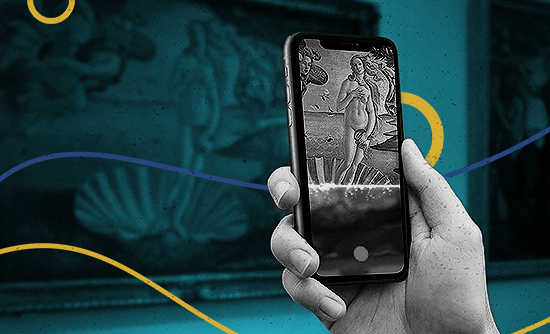How Museums Use Augmented Reality to Transport You in Time
 Zoox Smart Data - 23 de January de 2020.
Zoox Smart Data - 23 de January de 2020.
Augmented reality (AR) is the process of using technology to overlay images, text or sound on what a person can already see. It uses a smartphone or tablet to change the existing image through applications.
An example of this technology’s success is the game Pokemon Go. The technology makes the monsters seem to exist in the real world. The application received nearly 11.5 million downloads, which shows the technology potential to reach the general public.
AR provides the opportunity to add a third dimension to the screen, giving life to objects or scenes. Museums realized this technology could add gimmicks to attract customers and offer experiences in the virtual world too.
For many museums, it is a bet to stay relevant in a hyperconnected era.
“Museums are obviously doing their best to remain relevant because the world is increasingly fragmented and competitive in what it offers. A static object needs to compete more for our attention, “said the art historian and former director of the Whitney Museum, New York, Wired magazine.
Augmented reality can help contextualize the story by mixing the old with the new. Here are some interesting ways in which museums are using augmented reality.
Museum of Art of São Paulo
An application launched by MASP serves as an extra guide to the works of the museum. It expands the experience of visitors and makes the collection accessible to blind or handicapped via augmented reality. The technology to add layers of information to the visuals through text, audio, or other resources.
To use, you need to point a phone at a work of art. The camera recognizes the image and the application automatically plays the corresponding audio. The initiative follows a trend used by many museums in Brazil and in the world in recent years.
Museum of Tomorrow
How many whales fit in the museum’s lake? And why a Tyrannosaurus is prowling the Cube Matter? The museum’s new application answers these questions by presenting augmented reality experiences scattered throughout the exhibition for a unique visitor perspective.
For the museum’s content manager and head of the project, Leonardo Menezes, the application is an attempt to unite in one place the essential information for the visit to the augmented reality scenes, seeking to give the visitor the feeling of being immersed in the content.
The National Museum of Singapore
Besides the use to contextualize works in the collection, some museums have commissioned installations specially designed to be experienced with the help of augmented reality. It is the case of the work “Story of the Forest”, displayed at the National Museum of Singapore, which allows users to explore with the cell images Collection William Farquhar Natural History Drawings.
By the application, they have access to information about the habitat of species and how rare it is and can play to collect items such as plants and animals. They can point to the animal appear and find out information, creating your own encyclopedia with animals they encounter. Thus, the public can interact and explore the images in a new and exciting way.
Pérez Art Museum, Miami
In December 2017, the PAMM (The Pérez Art Museum Miami) worked with the artist Felice Grodin. Together they created the first exhibition of augmented reality-based art, called ‘Invasive Species‘. It aims to be a complete experience of RA, conjuring images of empty space.
The installation involved a series of digital images and species. This includes scary 3D models that evoke scary animals, jellyfish or enigmatic signs. It transports visitors to a future version of the building, acquired by invasive species.
There are also applications that want to use technology to “give back” to attendees of an institution works of art that have been stolen, putting them virtually in place that used to occupy the premise of the American project Hacking The Heist to restore works of a Boston museum.
Is there any risk of using augmented reality in museums?
Despite opened a new frontier for museums, augmented reality also brings some concerns. One is that its use isolates each visitor in his own cell, instead of allowing the person to open to enjoy the work in question or the interaction with other visitors. The curators of the museums also need to be careful that the RA facilities have no impact on the work of other artists.
Tip: What is the difference between augmented reality and virtual reality?
Virtual reality offers total immersion in a different reality. However, augmented reality shows reality and an altered version side by side. VR replaces what the user sees an alternative reality. AR adds to what you can already see. That means it can be helpful to write down scenes and provide extra information.
AR contextualizes the scenes and highlight contrasts with the current reality. Virtual reality requires specialized technology, such as headsets, controllers, and sensors. AR experiences just need a smartphone or tablet and can be downloaded as applications.






Comments